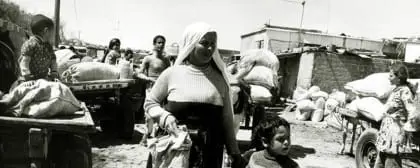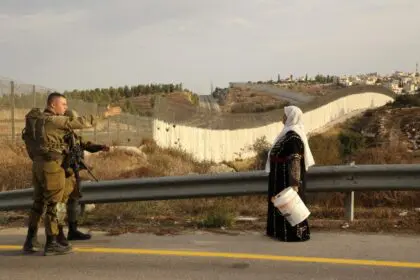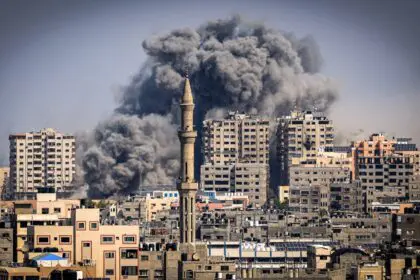Jenin Camp is historically renowned for its role in establishing the initial resistance groups against the Israeli occupation.

Youssef Sharqawi
Introduction
Jenin Camp is of a significant historical and political peculiarity within the Israeli-Palestinian conflict. Over the past two decades, Israeli forces have repeatedly attacked the densely-populated camp, claiming the lives of many Palestinians and destroying hundreds of homes.
Israeli forces recently carried out a military operation in Jenin Camp. Some newspapers described the operation that started on 19 June as a massacre. International and Arab media compared the recent Israeli attacks on Jenin Camp to those carried out during the Second Intifada in 2002.
Naturally, these recent Israeli attacks raise questions about the historical, political and even cultural reasons that make Jenin Camp Israel’s constant target.
History
Jenin’s historical legacy dates back hundreds of years before the camp’s existence. The city is considered a prominent stronghold of the Palestinians’ struggle against many invaders. In 1799, the residents of the city, located at the foot of the Nablus hills, set fire to their olive groves to halt the advance of Napoleon Bonaparte’s French forces towards the city. After the triumph of the French forces, Napoleon ordered his soldiers to burn and plunder the city.
References indicate that the first organised armed resistance against the British occupation of Palestine took place in Jenin. In 1935, Sheikh Izzeddin al-Qassam found a popular support base among the peasants in the city, who were eager to revolt against the British. Al-Qassam established his final base in the forests of Ya’bad, not far from Jenin Camp’s current location.
Jenin liberated itself from the short-lived Israeli occupation during the 1948 Nakba and came under Jordanian administration in 1949.
Jenin Camp was established in 1953 within the boundaries of the Jenin municipality. Akin to other camps in the West Bank, Jenin Camp was built on land leased from the Jordanian government by the United Nations Relief and Works Agency for Palestine Refugees (UNRWA).
Jenin Camp is the second-largest camp in the West Bank, with a population of approximately 27,000 people. According to UNRWA, the camp spans 0.42 square kilometres. The roots of the camp’s residents lie in the Carmel region, including the city of Haifa and Mount Carmel. Residents maintain strong ties with relatives inside the Green Line (territories occupied in 1948) due to the camp’s proximity to their original villages.
Jenin Camp remained an incubator for the resistance in the 1970s and 1980s. The first resistance groups were formed in the camp during the First Palestinian Intifada in 1987 and played a crucial role in shaping its course. In the mid-1990s, the camp came under the control of the Palestinian Authority. Over the years, it has suffered repeated attacks and massacres, most notably Israel’s infamous aggression in 2002, according to UNRWA.
In March 2002, in response to the Second Intifada, the Israeli army launched a large-scale military operation called the Defensive Shield. The operation targeted six major cities in the occupied West Bank, including Jenin and surrounding towns and camps that the Palestinian Authority initially controlled. Between 3 April and 18 April 2002, the Israeli army raided Jenin Camp with helicopters, tanks and bulldozers. The assault resulted in the extensive destruction of homes and infrastructure within the camp.
The Israeli occupation used the so-called mowing the grass strategy in Jenin Camp, utilising targeted assassinations of Palestinian activists under the pretext of security. As reported by the Palestinian Refugee Portal, the strategy also involved repeated invasions combined with widespread destruction, targeting a larger segment of the population.
Through its invasions, the Israeli forces aimed to reshape the camp by destruction, as they considered the urban layout, which allowed the population to politically and socially engage with the occupation, a threat. As a result, 455 houses were demolished, and 800 houses suffered partial damage.
Efforts were made to reconstruct the camp after the destruction. According to UNRWA, however, these were hindered by repeated Israeli incursions, curfews and closures.
After visiting the camp in 2017, Israeli historian Ilan Pappé wrote, “There is a clear distinction between the city of Jenin and the camp. You realise this when you leave the city and enter this huge camp built on a steep slope west of the city. It is also quite easy to identify which houses in the camp were destroyed during the 2002 massacre. When you climb to the top of the hill, you can see the location of the Israeli tanks that rained fire on the unarmed camp, causing devastation and death.”
He added, “Another thing you notice when you are on the hill is that you can see the entire area stretching from Jenin in the northern West Bank to the Mediterranean Sea. Through the Marj Ibn Amir – also known as Jezreel Valley – you can see the city of Haifa on the coast. The villages and towns that existed before 1948 were uprooted during the Nakba: the ethnic cleansing of Palestine by Zionist militias. Many people there were transferred to this area, so they can see from the hill how their homes and fields have been turned into Jewish settlements and forests for the Jewish National Fund.”
Culture
Despite the repeated incursions, Jenin Camp has a prominent position in the Palestinian cultural scene. Cultural activities thrive in the camp, producing works that reflect Palestinian daily life.
According to Palestinian poet Fares Sabaaneh, cultural productions have reflected the situation in Jenin Camp, but have been individual undertakings rather than collective.
The Freedom Theatre plays a significant role in Jenin Camp’s cultural scene, reflecting all of its features. Established in 2006 by Zakaria Zubeidi and Juliano Mer-Khamis, the theatre has produced 40 theatrical works showcased in various countries, including the United States and Europe.
According to Mustafa Sheta, the director of Freedom Theatre, the main goal of establishing the theatre was to connect culture and resistance.
Sheta emphasises, “Freedom Theatre is one of the most important theatres in Palestine and the region, attracting foreigners from various countries worldwide. We rely on local narratives based on events on the ground, especially since the theatre is located in the heart of the camp. Our production reflects the general situation and documents it.”
Politics
Jenin Camp, dubbed the Hornet’s Nest by the occupying forces, frequently makes headlines due to Israeli incursions and attacks.
The frequent Israeli attacks on the camp indicate the challenges Israel faces, as it aims to prevent the camp’s state from becoming infectious and spreading throughout Palestine.
Since the beginning of 2023, Israeli forces have launched over 50 attacks on the camp. Israel justifies these attacks by claiming they are targeting militants in the camp, calling it a centre for plotting extremist attacks, and claiming it to be a haven for militants funded by Hamas or Iran-backed Islamic Jihad groups.
Writer Adnan al-Sabbah describes Jenin Camp as the “camp of truth for all Palestinian refugees” for several reasons. First of all, because of the refugees’ origins in villages near the borders with Israel. The camp’s residents can see their original villages from within the camp. Second, due to the catastrophic social and economic conditions that the camp’s refugees endure. Compared to other areas in the West Bank, the camp’s residents live not only hoping to return to their original villages but also to escape the difficult humanitarian, economic and cultural circumstances that have overshadowed their lives.
On the other hand, the unity of factions within the camp is puzzling to its Israeli opponent, causing concern about its potential spread to other camps and Palestinian areas. Yair Plai, a commander in the Golani Brigade, even remarked that the members of these factions “are only affiliated with the camp,” making it a priority for Israeli security forces to neutralise the camp’s continuous active state.
The weak coordination on security between the Palestinian Authority and Israel factors in these repetitive Israeli attacks on the camp. The camp’s lack of security is attributed to the Palestinian Authority’s inability to provide Israel with relevant information.
However, clashes with the Palestinian Authority occur frequently inside the camp, as camp residents hold the Authority responsible for the arrest and murder of several of their fellow camp residents.
In April 2023, Gideon Levy and Alex Levac of the Haaretz newspaper prepared a report after entering the Jenin camp in secret.
Describing the camp’s current state as the most challenging and violent since the Second Intifada, the Israeli journalists highlighted the cemetery filled with the graves of martyrs: “Huge pictures of journalist Shireen Abu Akleh can be seen on the street around the corner. A rock has been placed where Israeli soldiers’ bullets killed Abu Akleh. This cemetery at the camp entrance tells the martyrs’ stories. We discovered a remarkable image of life when we entered the camp.”




